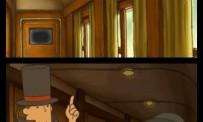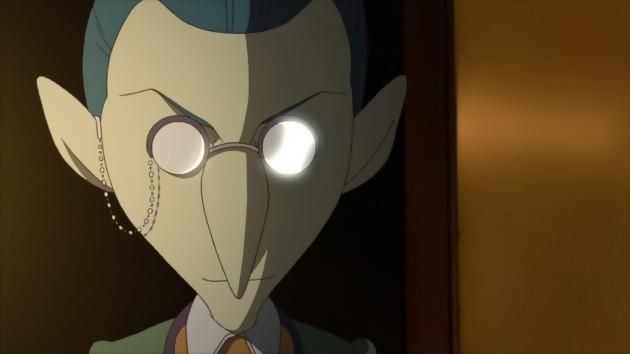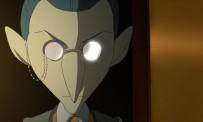 Unscathed from the quagmire of Saint-Mystère, Layton and his apprentice Luke are quick to return to business. To get our duo out of their temporary retirement, obviously something big had to happen. A blow that would imply an acquaintance, an intimate. Faithful to the good manners that characterize him, Layton could not decently ignore the request of Andrew Schrader, his mentor whose existence is threatened by the Celestial Box. If something were to happen to him, then Layton would have to continue his research on this artifact. According to the disastrous reputation that precedes it, its simple possession would entail a danger of death. As you can guess, the old man soon loses his life, struck by the curse of this Pandora's Box, a nickname given wrongly in informed circles. Leaving behind a Molentary Express ticket, a mysterious train to say the least, Schrader forces Layton and Luke to conduct their investigations towards uncertain destinations, which will take the form of two cities in addition to the few wagons that serve as their folklore. coach on the path of truth. This second opus of Professor Layton's first trilogy thus gains an airy universe, less confined than the few alleys of Saint-Mystère. A great point.
Unscathed from the quagmire of Saint-Mystère, Layton and his apprentice Luke are quick to return to business. To get our duo out of their temporary retirement, obviously something big had to happen. A blow that would imply an acquaintance, an intimate. Faithful to the good manners that characterize him, Layton could not decently ignore the request of Andrew Schrader, his mentor whose existence is threatened by the Celestial Box. If something were to happen to him, then Layton would have to continue his research on this artifact. According to the disastrous reputation that precedes it, its simple possession would entail a danger of death. As you can guess, the old man soon loses his life, struck by the curse of this Pandora's Box, a nickname given wrongly in informed circles. Leaving behind a Molentary Express ticket, a mysterious train to say the least, Schrader forces Layton and Luke to conduct their investigations towards uncertain destinations, which will take the form of two cities in addition to the few wagons that serve as their folklore. coach on the path of truth. This second opus of Professor Layton's first trilogy thus gains an airy universe, less confined than the few alleys of Saint-Mystère. A great point.
Nothing Layton
 In general, one could even say that it is all the artistic work undertaken on this new episode which is richer than before. In addition to the visit of these two cities and the train which links them, the gallery of characters intervening here is broader, more varied and even more alive than in Professor Layton and the Strange Village. The addition of countless voiceovers has a lot to do with it. The animated scenes are no longer the only ones to benefit from the work of actors, the key passages of the scenario also having the right to the addition of voices. Superb news slightly tarnished by – now – French services of fluctuating quality, even if it must be recognized that the whole thing is as good as the localization in general. The musical scores are also in tune and follow this same trend of enrichment. We will particularly remember the final theme iris ~Shiawase no Hako~ by Salyu which punctuates in the most beautiful way a story, which although taking up certain themes of its predecessor, is perhaps prettier, more touching. Strangely, it is on the trademark of the series that Professor Layton and Pandora's Box is the least inventive. The surprise effect being no more than a pleasant memory, the many followers of our gentleman with an impeccable headdress will very quickly thwart the subtly convoluted statements and the false puzzles of mathematicians. For two good big thirds of the adventure, this sequel offers only relative resistance that the addition of new types of puzzles fails to fill. The problems of chess, the variations of solitaire or the tower of Saigon are even a little too recurrent to really catch us at fault. When you also know that you just have to grope your way to pass these tests without a hitch, you say to yourself that our SOS coin hoard can rest easy. As regulars know all too well, Professor Layton wants to be close to a point'n click in its representation. Touching a character directly allows you to speak to him, while combing through the decorations is used to get your hands on currency that can be exchanged for a clue in the event of a blockage. The less persistent will be delighted to learn that they are particularly effective here, sometimes to the point of delivering the solution to us in a barely veiled way.
In general, one could even say that it is all the artistic work undertaken on this new episode which is richer than before. In addition to the visit of these two cities and the train which links them, the gallery of characters intervening here is broader, more varied and even more alive than in Professor Layton and the Strange Village. The addition of countless voiceovers has a lot to do with it. The animated scenes are no longer the only ones to benefit from the work of actors, the key passages of the scenario also having the right to the addition of voices. Superb news slightly tarnished by – now – French services of fluctuating quality, even if it must be recognized that the whole thing is as good as the localization in general. The musical scores are also in tune and follow this same trend of enrichment. We will particularly remember the final theme iris ~Shiawase no Hako~ by Salyu which punctuates in the most beautiful way a story, which although taking up certain themes of its predecessor, is perhaps prettier, more touching. Strangely, it is on the trademark of the series that Professor Layton and Pandora's Box is the least inventive. The surprise effect being no more than a pleasant memory, the many followers of our gentleman with an impeccable headdress will very quickly thwart the subtly convoluted statements and the false puzzles of mathematicians. For two good big thirds of the adventure, this sequel offers only relative resistance that the addition of new types of puzzles fails to fill. The problems of chess, the variations of solitaire or the tower of Saigon are even a little too recurrent to really catch us at fault. When you also know that you just have to grope your way to pass these tests without a hitch, you say to yourself that our SOS coin hoard can rest easy. As regulars know all too well, Professor Layton wants to be close to a point'n click in its representation. Touching a character directly allows you to speak to him, while combing through the decorations is used to get your hands on currency that can be exchanged for a clue in the event of a blockage. The less persistent will be delighted to learn that they are particularly effective here, sometimes to the point of delivering the solution to us in a barely veiled way.
Layton Hewitt
 Just as linear as its elder, the concept of the demanding series, Professor Layton and Pandora's Box is, however, sprinkled with a few extras that allow you to deviate from time to time from the cabbage catches, which it imposes on us during the big thirteen hours that it requires before the final clapperboard. Exactly three in number, these side quests always refer to the puzzles, whatever happens, since they require the acquisition of items that only their resolutions allow us to obtain. For example, Luke will have to develop small courses so that his obese hamster regains its healthy weight. By cleverly putting down various odds and ends ranging from the apple to the swimming pool, the little rodent will be forced to take more steps, which will have the effect of making it lose weight. Once at the top, he will help us flush out the SOS parts scattered everywhere. The reconstitution of a camera unlocks sequences of the “game of seven errors” type, where you have to compare two almost identical shots in order to come up with an enigma. Finally, a last quest asks us to find different tea recipes and serve them wisely when an NPC needs them. Not very exciting, it nevertheless deepens the universe in which we evolve. Worse, in any case, players who find these additions superfluous can always turn to the Extra menu and its small, well-bodied problems, or wait for the weekly puzzles to be put online to put their neurons to the test. Taken as a whole, Professor Layton and Pandora's Box is therefore a worthy successor. Perhaps unsurprisingly from a playful point of view, it nevertheless offers a rather welcome artistic richness and a scenario that makes the company of the professor and Luke always so pleasant.
Just as linear as its elder, the concept of the demanding series, Professor Layton and Pandora's Box is, however, sprinkled with a few extras that allow you to deviate from time to time from the cabbage catches, which it imposes on us during the big thirteen hours that it requires before the final clapperboard. Exactly three in number, these side quests always refer to the puzzles, whatever happens, since they require the acquisition of items that only their resolutions allow us to obtain. For example, Luke will have to develop small courses so that his obese hamster regains its healthy weight. By cleverly putting down various odds and ends ranging from the apple to the swimming pool, the little rodent will be forced to take more steps, which will have the effect of making it lose weight. Once at the top, he will help us flush out the SOS parts scattered everywhere. The reconstitution of a camera unlocks sequences of the “game of seven errors” type, where you have to compare two almost identical shots in order to come up with an enigma. Finally, a last quest asks us to find different tea recipes and serve them wisely when an NPC needs them. Not very exciting, it nevertheless deepens the universe in which we evolve. Worse, in any case, players who find these additions superfluous can always turn to the Extra menu and its small, well-bodied problems, or wait for the weekly puzzles to be put online to put their neurons to the test. Taken as a whole, Professor Layton and Pandora's Box is therefore a worthy successor. Perhaps unsurprisingly from a playful point of view, it nevertheless offers a rather welcome artistic richness and a scenario that makes the company of the professor and Luke always so pleasant.































